Charlie Sykes’ Private Island
His surprisingly modest Mequon Cape Cod is surrounded by and benefits from all kinds of publicly-funded, socialistic services.
Bedrock-conservative Charlie Sykes and his wife Janet F. Riordan share a conservative Mequon home built on bedrock in a neighborhood developed in 1942 when Mequon was still a town and not yet a city. Beneath the home lies the Niagara Escarpment of 300-million year old Dolomitic Limestone from the Upper Silurian Era.
So durable was this rock that when the glacier advanced upon it 10,000 to 30,000 years ago the great ice sheet was split into two lobes at Green Bay. The geologic formation extends in a great arc, embracing Lake Michigan and its sister Lake Huron. Its most notable feature is Niagara Falls.
Now that’s a foundation! Most of the rest of us are comparatively rootless, our homes, un-anchored to bedrock, adrift on clay. The “Niagara Escarpment,” as it is known, persists to this day as a visible feature in the City of Mequon, where bare cliffs of the ancient seabed can be seen along Cedarburg Rd.
Upon this stable foundation on the aptly named Ridge Road rests the home of Charles J. Sykes, the stalwart defender of conservatism who spreads his message through a multimedia platform that includes his WTMJ-AM talk show, a weekly TV show, his Right Wisconsin website (“Powered by Charlie Sykes,” the site declares), any number of books, an annual award honoring Margaret Thatcher and an exclusive wine tasting club.
The Sykes residence is perched on a steep 40-foot high bluff on the east face of the escarpment, where his home is blessed by the sweet kiss of the sun while the remainder of Mequon is still cast in the murky gloom of night. What better inspiration could there be than to look out over the treetops on the 4.5 acres of one’s own private property for a man to contemplate what the morning’s storyline will be, and to review and memorize the day’s talking points from the Republican National Committee?
The surrounding neighborhood is old, for Mequon, with about 10 original houses from 1936 to 1942, when the Sykes home was originally constructed, according to City of Mequon records. An original building might be the apparently unused garage-type structure located just feet off the road, and bearing now somewhat the nature of a potting shed. The Sykes residence, of whatever date, lies a proper distance back on a winding asphalt driveway.
That building appears to have had a quite recent addition toward the bluff, boosting the finished living area to a total of 1,917 square feet according to the assessor’s records. That is below average for Mequon.
A look at the place suggests a much larger structure. Perhaps the assessor has not been by in a while. But, based on the records, the home has a 1,166 square foot apparently unfinished basement, an 882 square foot rec room, 1,351 square feet on the first floor and 566 square feet on the second floor. The white frame structure is classified as a “Cape [Cod], Frame, 1.5 Story,” by the City Assessor. It has 2 bedrooms, 2 baths and one half-bath.
With a small set-up like that, it is rather certain that the three children of Sykes have listened to their paternal admonition as found in his 50 Rules Kids won’t Learn in School : Real World Antidotes to Feel-Good Education.
Rule #23: “Someday you may have to grow up and actually move out of your parents’ house.”
Well, with only two bedrooms, that’s pretty easy, dad!
The property is nicely landscaped and maintained, with ornamental shrubs and trees like ash, hawthorn and crabapples. However, it appears wild vines have their way on the northwest corner of the property, the border of which is marred by the presence of honeysuckle bushes. The government says we should get rid of honeysuckles, calling them invasive plants. Maybe that’s why Sykes still nurtures his.
The Sykes residence, some 730 feet above sea level, and 150 feet above Lake Michigan, is located near the center of the 46-square mile City of Mequon, and less than a half mile from the Village of Thiensville, the doughnut in the middle of Mequon that bills itself as “The Mile of Smiles.”
On the way to the tidy amusement park that is Thiensville, we pass the site of the old electric Interurban train station which opened in 1907. This was a stop for dozens of trains per day to and from the Great Metropolis to the south. Passengers shared the cars with milk cans headed from Mequon farms to the processing plants in Milwaukee. The Gilbert Shoe Company, based nearby in the land of smiles, shipped its product nationwide via the passenger trains that ran for 40 years just a couple hundred feet from the Sykes residence. The Sykes street was filled with homes during the late-Depression and early post-war years, while most of Mequon was agricultural, right up to the Thiensville Village limits.
Today the old rail corridor just downhill to the east is a bicycle path, and provides a straight shot bicycle route of 12.5 miles and 1.5 hours duration for any time the 60-year old would care to commute to his job at the WTMJ studios at E. Capitol Dr. and N. Humboldt Ave. in Milwaukee’s Riverwest neighborhood, of all places.
Or, if Sykes would like, he could bike the 1.5 miles from his home to the MATC North campus, where, if he is in luck and if school is in session, he could throw his bike on a “U” bus, and make it into town in just about the same amount of time as bicycling, but without the health benefits and the opportunity to explore the rare, exotic and endangered species of Mequon’s flora and fauna close at hand. Well, we know he wouldn’t do that anyway.
Sykes was a leading opponent of the bicycle rack on bus program instituted in 2009 after it had been ridiculed by him and then-county executive Scott Walker on Sykes’s show, frequently. Sykes said nobody would use the racks, and Walker was concerned about the $30,000 expense, vetoing the appropriation three times, and losing every time.
Today bikes-on-the-bus is so popular that over 150 bikes have been left on buses, and later donated to charity by MCTS.
These forgetful kids today! What were they thinking? Don’t they teach them responsibility in school? Or, as Sykes would have it in Rule #40 of his 50 Rules Kids won’t Learn in School, “Despite the billion-dollar campaign to turn your brain into tapioca pudding, try to learn to think clearly and logically.”
For example, remember where you left your bike, and don’t think that creating 21st century transit links to Mequon would be a clear and logical thing. Go ahead and drive to work, like Charlie does. Drive everywhere, as his aging corps of suburban listeners does, and listen to all 50,000 watts of AM 620, WTMJ, particularly during weekday drive time, 8:30 a.m. to noon. And while you’re at it, don’t forget Rule # 42: “Change the oil.”
Area’s Link to Alexander Hamilton’s Son
In 1825, William Stephen Hamilton, the son of Alexander Hamilton, drove a herd of 99 cattle from Illinois to Green Bay. A settlement is named in his honor just up the federally funded Green Bay Road (surveyed 1832-1833), a highway that greatly improved travel conditions.
The route Hamilton took was almost undoubtedly the Indian trail running along the bottom of the bluff on what is now the Sykes homestead. Back then it took five days to travel from Chicago to Green Bay, and “a wheeled vehicle could not be operated north of Milwaukee.” So the White Man simply freely used the trails that the Indians had blazed, and nobody thought twice of it, except perhaps the Indians.
In 1849 an acre of Mequon land in the Sykes highlands fetched $3.22, “the highest in the whole county,” a historian noted. Sykes owns 4.5 acres of that land, now valued at $197,200 — more than the $190,200 value of his home itself. The 2014 tax bill for the $387,400 property was $4,861.29.
The tax is paid in full, with some of it going to support Mequon’s public school system and general government operations, like its library and swimming pool. Some goes to Ozaukee County, where the pointy-headed bureaucrats in Port Washington will spread it around to loafers and freeloaders who are shiftless and can’t fend for themselves in a competitive society. The latter should consider Sykes’ Rule #1: “Life’s not fair. Get used to it.”
Only a portion of the Sykes estate sits high on its bluff. A good deal of it lies below in a swampy area where Pigeon Creek struggles to find its course. It was well described by the historian: “Friestadt — High rolling land, heavily timbered, well-watered and neighbored by an extensive marsh on the public domain which would furnish free hay and pasture.” That free pasture and that free hay grew on what is now the Sykes homestead.
Nation of Moochers!
According to promotional material for Sykes’ most recent book, A Nation of Moochers: America’s Addiction to Getting Something for Nothing, “self-reliance and personal responsibility have given way to mass grasping after entitlements, tax breaks, benefits, bailouts, and other forms of feeding at the public trough.”
And here folks were feeding their cattle at the public trough on private land in Mequon back in the mid-nineteenth century!
Even worse, in 1842, William T. Bonniwell, whose land neighbored the Sykes domain, was appointed the County Poor Commissioner. The “county commissioners allowed him $20 in pork and flour to be distributed among the poor of the county.”
The county’s poor in the early 1840s were Yankees of Anglo-Saxon and Irish origin, as were the county’s wealthy, like settlers Bonniwell, John O’Brien and Taylor Hevilon. Hevilon’s deed for 160 acres that now contains the Sykes homestead was signed by Martin Van Buren, Jr., son and secretary of the president in 1840.
The land had been surveyed in March 1836 by W. A. Burt, an agent of the federal government charged with snooping around Michigan Territory quarter-section by quarter-section and submitting his maps and field notes to government paper shufflers in Washington before the lands could be offered for sale.
He found the land to be “rolling, good,” and studded with trees. “Beech, 10 in. diameter, Beech 28 in. … Sugar Maple 11 in. .. 15 in. … 24 in, Hickory 20 in. B. Oak 22 in, Elm, Ironwood … Stream [Pigeon Creek] 8 links wide.” None of these trees are likely to remain on the property, but were promptly sent to Peter Turck’s sawmill, built in 1840 less than a mile away.
Settlement Soon Overrun by Immigrants
By 1850 — just a decade after it was settled — the area around the Sykes property was overrun with immigrants. A census found “Germans 310, Irish 38. Yankees and English were so few they were not noted.” Is this any way to settle a new land? With such wretched refuse, homeless and tempest-tost?
Not only were these aliens from the Vaterland new to this country, they voted freely in elections, even though they were not citizens! And we’re worried about Voter ID abuses today. (Well, Sykes is.)
Some of these foreigners, still undocumented aliens, still not citizens, perished in the Civil War, fighting for their new homeland. We are grateful for their sacrifice.
But some survived, wounded, like Valentin Schultz of “Mequon River,” shot through the head and discharged in September, 1863, returning to home partly paralyzed after only nine months of service to his country.
Fourteen years later, in 1877, the federal welfare state granted Schultz an $18 per month pension, which he was still collecting in 1883, just sitting by the mailbox, waiting for the money to roll in, as soon as the Treasury could print it.
Mequon’s Germans also took their part in later wars. A list of the local casualties of World War I, filled exclusively with German surnames, makes you wonder which side they were fighting on, but most of these were second-generation children of original immigrants.
They took advantage of the loophole in the immigration law granting children born here full citizenship rights, even if their parents were undocumented aliens. Today their children’s children’s children are scattered throughout the countryside. Indeed, they may dominate life in Ozaukee County, which has the state’s highest per capita income.
Meanwhile Mequon, the largest city in the state’s smallest county, continued its slide into socialism. A public school bore the name of Henry David Thoreau, a pacifist tree-hugger. The 19th century building was later converted into an American Legion Hall, and then torn down last year to create a new Mequon Town Center, all in the name of progress. The new Mequon Town Center relied on government funding in the form of a TIF District and other inducements as has the Mequon Business Park and two redevelopment corridors on N. Port Washington Rd.
Mequon Love Affair with Socialism Continues into 21st Century
The Mequon Town Hall, dedicated in 1937 and still serving as City Hall today, was built by Franklin D. Roosevelt‘s Federal Work Progress Administration.
Uncle Sam’s New Deal paid for the bricks, the concrete, even for the adjoining swimming pool and changing stations — right down to the baskets where swimmers put their clothes. This is how we get out of a Depression? With taxpayer-funded swimming pools for local kids and ne’er-do-wells to go frolicking while they wait for their government rations of pork and flour, their children growing fat and complacent on free school lunches?
And the labor for the Town Hall and Swimming Pool? That was furnished by the Ozaukee County Relief Department, obliging those shiftless Depression-era idlers into working for their government handout for a change.
The long arm of the government continued its reach into the private affairs and property of Mequon residents like Sykes. Back when his home was built, disposal of sewage was a simple matter, handled on-site with the help of a septic tank, friendly microbes and a leachate system draining into Pigeon Creek and the Milwaukee River below. Simple, effective, and you didn’t have to write a check to the government every four months to pay to get rid of the sewage that you made yourself, and should have a right to store in your own back yard, or downstream in the neighbors’.
Today, the Sykes residence is served by the Milwaukee Metropolitan Sewerage District, operators of the successful Deep Tunnel, which Sykes has long derided as a taxpayer-funded government boondoggle. Part of his tax money, and his socialist sewer bill payments, go to support this government monopoly. Talk about waste!
But at least his water is free for the price of pumping. Others in Mequon are not so lucky. Some of southeast Mequon relies on water pumped from the North Shore Water Commission, a government-owned corporation, and sold to customers by the City of Mequon Water Utility, yet another government-owned corporation.
This latest intrusion into the rights of private capital occurred when the city of Mequon inherited a bankrupt private water utility in 1992 supplying 500 homes in four subdivisions. The city invested $3 million into it, just to keep the residents served by it from dying of thirst. But the city had no expertise in running a water utility, then Mayor Curt Gielow said in 1998, suggesting it should be privatized and sold to the Wisconsin Gas Company for $1 and existing debt, to be recovered from water rates. “I don’t think the city should go about this deal to make money,” Gielow said, as he handed control of the municipal asset to the giant privately owned public utility. And, just guess who did make money?
Turns out the gas company and its successor WE Energies didn’t have any expertise running a water utility either, and in 2008 the city was forced to buy back its water utility for $14.8 million of taxpayer money when the almighty private sector couldn’t make a go of it. Such is the socialist city that surrounds the private world of Charles J. Sykes.
The Rundown
- Location: City of Mequon
- Neighborhood: Freistadt
- Subdivision: None; part of 160 acres bought in 1840 by Taylor Hevilon
- Year Built: said to date to 1942, but that might just be the old structure in the front yard. Records are scarce. Mequon had a weak town government back then when citizens acted on their own and didn’t carry much truck with permits, fees and government interference with private property rights.
- Style: Cape Cod Frame, unobtrusively pleasant good taste.
- Size: Said to be 1,917 square feet. Sure seems larger.
- Fireplaces: Looks to be one on the north wall of the older part of the home.
- Taxes: $4,861.29 in 2014, down from $5,320.35. Thank you, Scott Walker!
- Assessment: Land $197,200 [$1/s.f.], Improvements $190,200; Total: $387,400.
- Walk Score: 22 out of 100. “Car-Dependent” But you can actually get somewhere from this house. Thiensville has a lovely little coffee shop in Fiddleheads, the Thiensville Farmer’s Market is readily accessible, and Charlie can easily stroll over for a happy frolic at Thiensville Fireman’s Park.
- Transit Score: None recorded, but it can’t be good. Interurban railroad once whisked passengers to Milwaukee dozens times daily from station down the street.
How Milwaukee Is It? The residence is 18.5 miles from Milwaukee City Hall by car, via the freeway, of course, with the radio locked to WTMJ 620 AM.
Photo Gallery
House Confidential Database
| Name | City | Assessment | Walk Score | Year |
|---|---|---|---|---|
| Name | City | Assessment | Walk Score | Year |


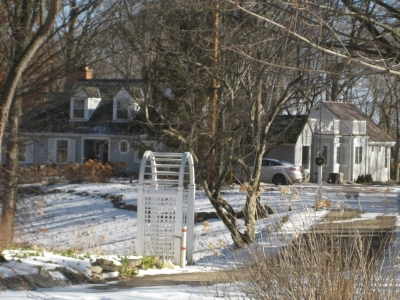
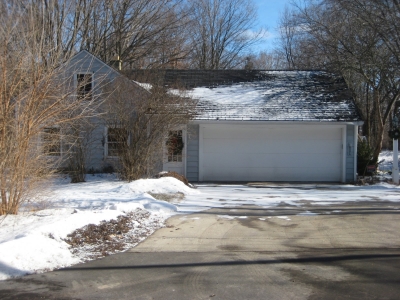
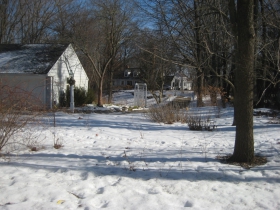
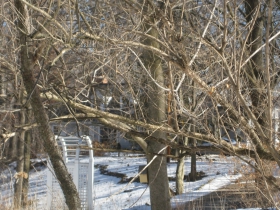
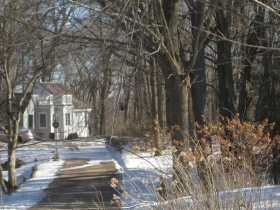
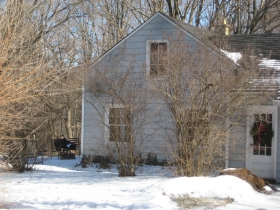

















I just know this House Confidential will draw the same ire and outrage as Jeff Sherman’s did. Right?
I don’t see the 55-gallon drums containing the tears of the downtrodden in the photos. Sykes must have buried them along with any acknowledgment of Walker’s 2.2 billion dollar budget hole.
Sure looks like someone has done some remodeling without a permit, but not too surprising for someone so adverse to “government intrusion”.
My God, this is the most heavily biased piece of “journalism” I’ve seen in quite a while. Frankly, this is the sort of thing I warn my students about when we’re talking about information literacy, and to be aware of hidden biases in media.
While your “About You” section doesn’t mention an obvious liberal bias, a comparison of this piece with that on Gwen Moore highlights the bias quite strongly. Shame on you for purporting to be a publication that “seeks to provide an informative and open dialogue” when in fact you’re not providing an open dialogue, at all. If you’re going to be a liberal publication, share that with your readers.
And, by the way…”his home is blessed by the sweet kiss of the sun while the remainder of Mequon is still cast in the murky gloom of night.” Seriously? How ridiculous.
Are the House Confidential columns supposed to be treated as hard news or something? You seem to be overreacting a bit.
Mary Beth, hidden biases in media? have you ever listened to Charles J. Sykes. I hope you warn your students.
JW, I think her point was that it would be different if the writer is upfront about their bias than it is no longer attempting to appear as anything but coming from a particular side… thus no longer being a “hidden bias.” If nothing else, we can say Sykes does not hide where his bias may lay…
House Confidential is pretty much a fluff piece with great historical anecdotes dropped in, it’s well-known by those that have read past columns. Is this the right-wing version of PC? You need to be told someone is using sarcasm?
I’m shocked! Shocked I tell you that the eminence grise of factual personal domicile journalism would stoop to such mellifluous, scurrilous sarcasm about a pillar of the journalistic class, a noted paragon of fair and balanced reportage at its most righteous!
Great piece, Michael.
The scariest thing about it is the comments-section revelation that Mary-Beth Sancomb-Moran teaches young people.
The article is very interesting. I assume that the history of the area is depicted honestly. A lot of stuff I didn’t know. The slant of the article is purposely biased which is unfortunate but that should be pointed out to students when teaching local history. They are able to grasp a situation. Name calling is unacceptable.
I currently attend Marquette’s “Alumni in the Classroom” program offered to those who graduated before 1966. I audit a history course. It would be great to discuss the value of this article with the students of today. They are our heroes. I’m sure they will be able to judge the content fairly and lead the world in the future.
Masterful piece, Michael, “hidden biases” and all.
It should be noticed that Prince Charles is shacked up there with his third wife. Hooray for “family values”!
Mequon is beautiful and I can understand why Charlie lives there, highest median income in the state and median home prices $400,000 and #1 school district in the state and yes some of the lowest property taxes in the Milwaukee 7 county region. We had a home in Milwaukee and were paying almost $10,000 A YEAR!!! Then moved to mequon and now our property taxes are $3,000. Oh and we live on 1.5 acre lot. You just get more for your money in the suburbs.
Nice bit of history, and a perfect rip on one our our community’s leading professional axe-grinders.